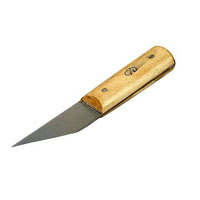 In this manual, we want to describe the features of working with such a seemingly simple construction tool as a shoe knife . Structurally, this tool is very different from other types of knives. It has a short thick handle and a short beveled blade.
In this manual, we want to describe the features of working with such a seemingly simple construction tool as a shoe knife . Structurally, this tool is very different from other types of knives. It has a short thick handle and a short beveled blade.
In this case, the blade has a one-sided shape of the blade chamfer. That is, the blade is sharpened only on one side. Thanks to this design, the shoe knife allows you to cut a large number of different building materials, as well as use it for a variety of other jobs.
Tool inspection
Before starting work, you need to make sure the integrity of the tool. The blade in the handle must be held without play (do not stagger), and also not have cracks, bends or other damage. The blade should be well sharpened and not have dents or chips on the cutting edge.
Such damage can occur, for example, if, when splitting a plank with a knife, a nail meets in it in the path of the knife. Also, the edge can be broken during sharpening the blade on a coarse stone or grinding wheel. After making sure that the tool is in good condition, you can finally get to work.
Cutting various materials with a knife
Since a shoe knife can be used to cut a wide variety of materials, cutting techniques can vary significantly. This is due to the different density, thickness and physical properties of building materials. In fact, there are two main types of cutting with a shoe knife, we will try to describe them in more detail.
1. Pressure cut method
A similar method of cutting the material is used for materials such as linoleum, polyethylene, carpet, polystyrene and other flat materials up to 1 cm thick (depending on density). Of course, this parameter is quite relative, since if it is linoleum, then it is of course much thinner, and the foam plastic can be much thicker and much larger, although it will be more difficult to cut it with a shoe knife, since it will crumble due to the fact that the knife blade is quite thick.
The technology itself is as follows: The material to be cut is placed on a flat surface. Next, a dense material is placed under the cut line so that the main surface is not damaged. Plywood, hardboard or boards are best suited for this. Next, we cut the edge of the material along the previously drawn line. After that, insert the knife into the incision, resting it on the material underlay. The knife must be held at an angle.
As for the exact numbers, which angle must be maintained is very difficult to say, since the denser the material and the thicker, the more resistance the knife blade experiences and the angle should be sharper. Next, pressing on the blade so that it cuts a little and the main and underlying material begin to move it along the line. In this case, the material is cut. The position of the knife must be in the same position relative to the plane of the material being cut.
You need to hold the handle with a direct grip (like a regular knife). However, if the material is very dense, it may be necessary to cut with a reverse grip (knife grip from above). Since a lot of force must be applied to the knife when cutting dense materials, it is better if a man does this. The cut must be made in one motion, then you can get an even perpendicular cut.
2. Press method
This cutting method is used when cutting hard plastics. For example, cutting plastic panels, cutting profiles of plastic elements, etc. The technology here is somewhat different. In fact, we can say that you have to cut not by moving the knife, but by the material itself, although this is not an entirely accurate definition. You can both move the knife relative to the material, and the material relative to the knife. During cutting, the knife is placed in such a way that the sharpening edge is perpendicular to the plane of the material.
Next, press the knife and cut through the material. More precisely, we push the knife through the material. It is not by chance that we noted that this method is well suited for cutting durable thin plastic, as it allows you to very accurately cut the material along the desired line. As a variation of this method, the technology of cutting the material can be noted. The material is gradually cut off (like a pencil) to the desired mark. Very often this is much easier to do than cutting the material at once.
Also, the knife can be used as a mini ax for splitting planks or trimming them. In this case, a hammer is used as an additional tool, which is tapped on the knife blade. And of course, a shoe knife is indispensable for cutting various ropes, plastic cords, removing braid from electrical wires and other work. The most important thing is not to use the knife for unusual work, such as tightening screws. In this way, you will only spoil the instrument.